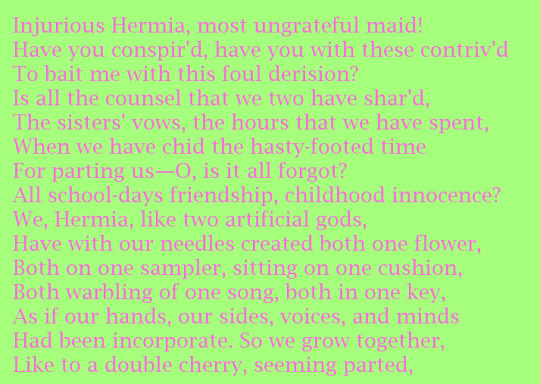#helena and hermia were gay and the entire world just has to live w it
Explore tagged Tumblr posts
Photo


Monologue of the character Helena to Hermia, from William Shakespeare’s A Midsummer Night’s Dream, a fantasy romantic comedy written in the 1590s, one of the earlier plays of his career and one of only a few with no prior literary or historical source for the plot
Expressions of same-sex affection can be found throughout Shakespeare’s sonnets and plays, including The Merchant of Venice, As You Like It, Twelfth Night, Coriolanus, and Two Noble Kinsmen. However, the Renaissance did not have the modern concepts of sexual identity and sexual orientation that we have inherited from 19th- and early 20th-century theories of human sexuality and psychology. Hence nobody in this period would have conceived of themselves in terms of modern sexual categories such as heterosexual and homosexual, or gay and straight. The challenge in reading passages such as this is to understand the personal, social, and political significance of same-sex relationships in Renaissance culture without applying anachronistic labels or standards of judgment. In Renaissance England, intimate relationships between women were generally accepted as long as they did not interfere with the women’s conventional sexual and social duties: getting married, having children, maintaining chastity, and behaving in an appropriately feminine manner. In A Midsummer Night’s Dream and As You Like It, adolescent female friendships finally give way to the new bonds between husbands and wives that signal entry into adulthood. However, being married did not prevent adult women from maintaining or establishing affectionate intimacies with other women through relationships of friendship, patronage, or service.
—Annotation in Barnes and Noble Shakespeare’s edition of the play (the first edition I read when I was seventeen), edited by Mario DiGangi
#this annotation i used to reread and reread because it made me feel very valid#there was literally a dent in the book on this page. not bc i bent it but because i opened it to this spot so much hahahaha#i kept a thick bookmark in it too#a midsummer night's dream#shakespeare#william shakespeare#influences#monologue#elizabethan theater#renaissance poetry#renaissance theater#elizabethan poetry#romantic comedy#sapphic poetry#queer literature#helena and hermia were gay and the entire world just has to live w it#important for personal historical context but this was the first shakespeare play i ever read on my own and it's still my favorite#tied w the tempest with a&c as an honorable third place#i used to think this play kept being my favorite bc the b&n edition was so good and approachable for my reading level#when i first got the riverside shakespeare (1973) from my grandmother. i read like five or six plays in the next six months or so#(maybe more? i forget. i dont wanna go back and count it's not that significant the point is i was bingeing)#but i thought the riverside shakespeare might've just been a little too 'scholarly' for me and that's why midsummer kept being my top#but it really is just one of my favorite pieces of art ever fathomed... perfectly psychedelic and original and dianacore#much of the originality and imagination that i love in this play it also has in common w the tempest which is why they're tied#sigh... i could talk about those plays forever
16 notes
·
View notes